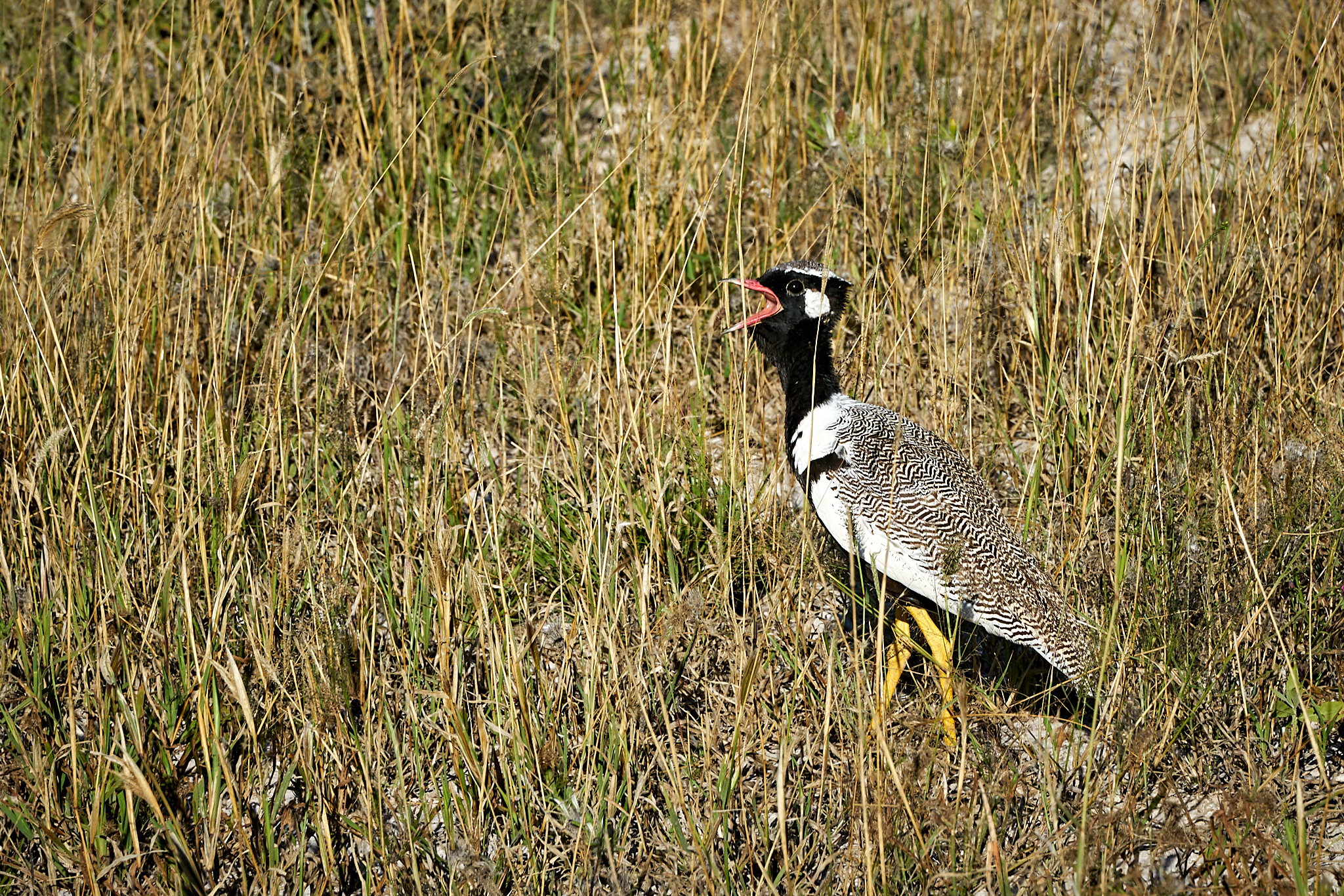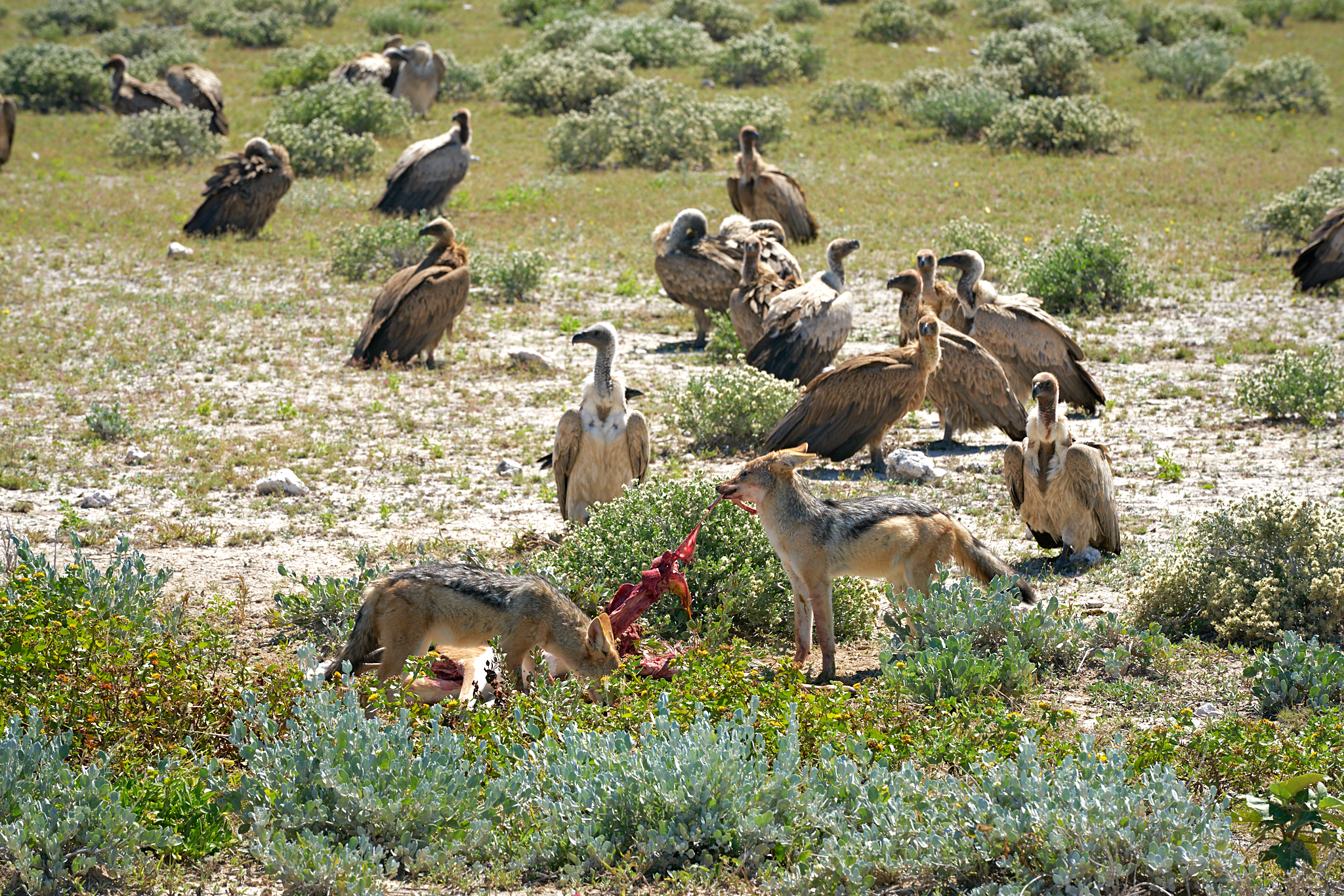Valaise Blacknose Sheep

Valaise Blacknose Sheep in front of the Matterhorn in Zermatt, Switzerland
Click image to enlarge
Etosha National Park, Namibia
Days 11-12. When planning our trip, we designed the last few days to be a little on the easier and more comfortable end of the safari spectrum. Rather then set up our own tents and cook our meals while isolated in the deep wild, we decided to stay in two different safari lodges (complete with hot showers and beds…and crowds of clean tourists and all you can eat buffets overlooking watering holes). It was a bit of a shock, and we felt awkward experiencing Africa in this more controlled and catered manner. The first two days were spent at the Halali Camp, and luckily our original guides stayed with us at this camp and also took us on the early morning and evening game drives in Etosha National Park. Click to enlarge images.
Crismon-Breasted Shrike
There was nothing in Namibia that impressed us more than the spectacularly beautiful mating season courtship rituals of the crimson-breasted shrike.
Jackals and Hide
Namibia Day 11 began with a morning game drive, our first at Etosha National Park. Soon into the drive we came across a fresh kill, a springbok that had been taken down recently by presumably a cheetah. By the time we arrived, the cheetah had eaten its fill and moved on, leaving the remains for the scavengers. What ensued appeared as somewhat of a survival “dance” between the jackals and the vultures as they repeatedly parried each other for a chance to feed.
Click on the image below to view a short video of the encounter. Caution: Gory! Also, please change quality to 1080p (auto is 720 ) and view full screen!
Damaraland to Etosha, Namibia
Day 10 brought a drive out of the wild and into “civilization”. We were headed to Etosha National Park (with showers and beds), a 22,270 sq km/8,600 sq mi park which gets its name from the Etosha Pan, a salt pan which covers a quarter of the total area of the park and is so large that it is identifiable from space. Our drive to the park took us through scattered Damara villages, where farmers who subsist on herding cattle, sheep, and goats still live primarily in simple homes constructed from dung and termite mud (collected from MASSIVE termite hills) spread on a wooden frame.
Massive termite hills were scattered throughout the countryside.
Himba Women out for a stroll
Springbok “pronking”
 Kori Bustard
Kori Bustard
Rainbow Sunset Over Palmweg Concession in Damaraland, Namibia
The long day 7 drive through the concession area was a slow, difficult, and at times uncomfortable (very steep terrain mixed with heavy rains) journey. As we arrived and searched out a campsite, the clouds began to clear and we were treated to a spectacularly beautiful double rainbow sunset over the camp. We were now as far out of touch from the rest of the modern civilized world as I have ever been. Over dinner our guide Sasha described the “lion” protocol for the camp (imagine him telling us this at night as light from the small fire flickered on half of his face): Never leave your tent alone at night. Need to pee? Take the bucket from outside your tent door into your tent, pee, put the bucket back outside of the tent. Need to do a #2? Wake the three men up and walk as a group to the makeshift toilet as you scan the surroundings with headlamps for reflective “eyes” around camp. Hear something at night creeping outside your tent? Don’t move, make a noise, or turn on your light. Do not call for anyone. Follow these rules, and you likely will not get eaten. We all slept great after that. And for the record, we did hear some hyenas not too far from camp as we were falling asleep.
This is my favorite photo from the entire trip. Click to see it in full resolution!
Erongo Mountains to the Damaralands D6
The Day 6 Namibian agenda called for us to drive out from the Erongo mountains and head into the scenic Damaraland, a massive, untamed, and ruggedly beautiful region in the north-central part of Namibia which is home to one of the oldest nations in cultures in Namibia, the Damara people. Our Damaraland landscape starts with open plains and grasslands, granite hills and deep gorges, but changes dramatically to endless sandy wastelands. Somehow, though, the Damaraland is able to sustain a wide-ranging variety of animals which have all adapted to survive in this harsh and almost waterless desert. Two notable sites along the way were The Brandenburg aka “Fire Mountain”, Namibia’s highest mountain, as well as a tour of the San (Bushman) rock art in Twyfelfontein, a site that has been inhabited for 6,000 years and was used for a place of worship and a site to conduct shamist rituals. Throughout the rituals, at least 2,500 items of rock carvings have been created, and as one of the largest concentrations of rock art in Africa, has been designated an UNESCO World Heritage Site. Click to enlarge.
Himba woman in traditional clothing
The Brandberg ‘Fire Mountain’, from the effect created by the setting of the sun on its western face, which causes it to glow red like molten metal.
Twyfelfontein, one of the most extensive galleries of rock art in Africa.
Springbok grazing at dusk (one of my favorite pics from the trip)
Welcome to Aabadi campsite, guys!
Sunset over the Damaraland

Sundowner at Bulls’s Party, Namibia D5
Our second hike on day 5 sent us straight into a rainstorm as it rumbled towards our afternoon sundowner (happy hour) destination, Bull’s Party rock formation. Bull’s Party formation stems from regional volcanic activity dating back 110-130 million years, followed by erosion of the earth’s surface, which resulted in massive granite blocks being exposed throughout the area. Millions of years of extreme day/night temperature fluctuations caused the blocks to chip off and form rounded boulders, which rolled down into the valley. The formation gets its name from the belief that the boulders resemble a group of bulls facing each other.
We enjoyed our anti-malarial Gin and tonics under cover of the massive granite boulders as the sky opened up and torrential rains created streams and waterfalls where seconds earlier there were none. The Gin Gods were smiling down on us though… for the rains ended as abruptly as they began, and, as the sun set below the clouds, our surroundings were illuminated by an unearthly yellow-orange hue. As we left the protection of the rocks and headed back to camp, the intense colors made it feel as though we were walking across a Martian landscape. As the eerie colors faded, the clouds gave way to the last rays of the sun and a magical perfect double rainbow over the Elephant Head cliff formation. As always, click to enlarge.
Baboons taking shelter from the approaching storm
Bull’s Party Panorama
Taking our medicine: anti-malarial Gin and tonics
Walking on Mars
Elephant Head cliff formation
Erongo Mountains, Namibia D5
Day 5 in Namibia found us setting out at sunrise on a hike through the Erongo plains to visit Phillipps Cave, a shallow cave hidden in the steep granite cliffs of the Erongo mountains. The cave, which is a national heritage site, is famous for it’s cave paintings by the nomadic San People (Bushman), which include hunting scenes, antelopes, giraffes, rhinos, ostriches, antelope, springbuck, kudus, zebra, the famous white elephant, and 6 imprints of human hands. Some of the paintings date back to approximately 3368 BC. As always, click to enlarge.
Sunrise Hike to the Cave
Man Hunting Ostrich
Antelope
White Elephant.
Men Standing in Cave
Man Sitting in Cave
Family Sitting in Cave
View from Phillipps Cave
Stone tools dating to 3500 years BC,
View from Phillipps Cave
Bearded Dragon protecting the cave
Ants drying their grass seed harvest, a morning ritual.
Female Greater Kudu welcoming us on our return to camp































































































